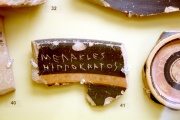Eta
From Textus Receptus
Eta (uppercase Η, lowercase η) ἦτα) is the seventh letter of the Greek alphabet. In the system of Greek numerals it has a value of 8. Letters that arose from Eta include the Latin H and the Cyrillic letter И.
Contents |
History
In the modern system of writing Ancient Greek, eta represents the long vowel |ɛː|. In Modern Greek, it represents i|. When the letter was first borrowed, it represented h|. The letter was borrowed into the Cyrillic alphabet as И.
Consonant h


See Also Heta (letter)
The letter shape H was originally used in most Greek dialects to represent the sound /h/, a voiceless glottal fricative. In this function, it was borrowed in the 8th century BC by the Etruscan and other Old Italic alphabets, which were based on the Euboean form of the Greek alphabet. This ultimately gave rise to the Latin alphabet with its letter H.
Long e
In the East Ionic dialect, however, the sound /h/ disappeared by the sixth century BC, and the letter was re-used initially to represent a development of a long vowel /aː/, which later merged in East Ionic with /ɛː/ instead.[1] In 403 BC, Athens took over the Ionian spelling system and with it the vocalic use of H (even though it still also had the /h/ sound itself at that time). This later became the standard orthography in all of Greece.
Other regional variants of the Greek alphabet (epichoric alphabets), in dialects that still preserved the sound /h/, employed various glyph shapes for consonantal Heta side by side with the new vocalic Eta for some time. One of them was a tack-like shape, looking like the left half of an H. This system was first used in the southern Italian colonies of Heracleia and Tarentum. When Greek orthography was codified by grammarians in the Hellenistic era, they used a diacritic symbol derived from this half-H shape to signal the presence of /h/, and added as its counterpart a reverse-shaped diacritic to denote absence of /h/. These symbols were the origin of the rough breathing and smooth breathing diacritics that became part of classical Greek orthography.[2] The tack symbol has been reintroduced into modern scholarly representation of archaic Greek writing under the name of Heta.
Iotacism
During the time of post-classical Koiné Greek, the /ɛː/ sound represented by eta was raised and merged with several other formerly distinct vowels (iotacism). Thus in Modern Greek, Eta is pronounced [ˈita] and represents the sound /i/ (a close front unrounded vowel). It shares this function with several other letters (ι, υ) and digraphs (ει, οι), which are all pronounced alike (see iotacism).
Cyrillic alphabet
Eta was also borrowed with the sound value of [i] into the Cyrillic alphabet, where it gave rise to the Cyrillic letter И.
Uses
Letter
In Modern Greek the letter, pronounced ˈita, represents a close front unrounded vowel, /i/. In Classical Greek, it represented a long open-mid front unrounded vowel, /ɛː/.
Symbol
Upper case
The upper-case letter Η is used as a symbol in textual criticism for the Alexandrian text-type (from Hesychius, its once-supposed editor).
In chemistry, the letter H as symbol of enthalpy sometimes is said to be a Greek eta, but since enthalpy comes from ἐνθάλπος, which begins in a smooth breathing and epsilon, it is more likely a Latin H for 'heat'.
Lower case
The lower-case letter η is used as a symbol in:
- Thermodynamics, the efficiency of a Carnot heat engine.
- Chemistry, the hapticity, or the number of atoms of a ligand attached to one coordination site of the metal in a coordination compound. For example, an allyl group can coordinate to palladium in the η¹ mode (only one atom of a allyl group attached to palladium)or the η³ mode (3 atoms attached to palladium).
- Optics, the electromagnetic impedance of a medium, or the quantum efficiency of detectors.
- Particle physics, to represent the η mesons.
- Experimental particle physics, η stands for pseudorapidity.
- Quantum field theory (physics), to represent the metric tensor.
- Statistics, η2 is the "partial regression coefficient". η is the symbol for the linear predictor of a generalized linear model, and can also be used to denote the median of a population.
- Economics, η is the elasticity.
- Astronomy, the seventh brightest (usually) star in a constellation. See Bayer designation.
- Mathematics, η-conversion, see lambda calculus
- Mathematics, the Dirichlet eta function, Dedekind eta function, and Weierstrass eta function.
- Biology, a DNA polymerase found in higher eukaryotes and implicated in Translesion Synthesis.
- Neural network backpropagation, η stands for the learning rate.
- Telecommunications Eta stands for efficiency
- Electronics, η stands for the ideality factor of a bipolar transistor, and has a value close to 1.000. It appears in contexts where the transistor is used as a temperature sensing device, e.g. the thermal "diode" transistor that is embedded within a computer's microprocessor.
- Power electronics, η stands for the efficiency of a power supply, defined as the output power divided by the input power.
- Atmospheric science, η represents absolute atmospheric vorticity.
- Rheology, η represents viscosity.
References
- 1. Sihler, Andrew L. (1995). New Comparative Grammar of Greek and Latin (illustrated ed.). New York: Oxford University Press. pp. 10–20. ISBN 0195083458. .
- 2. Nick Nicholas (2003), "Greek /h/"

